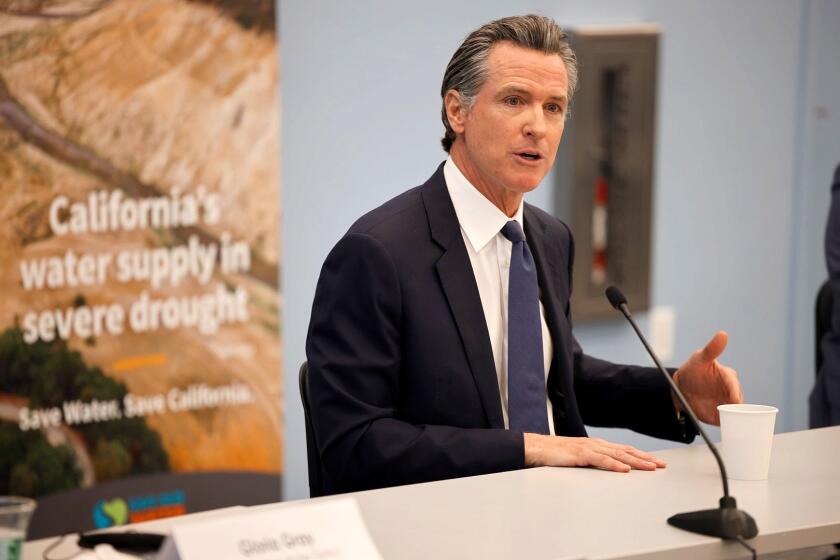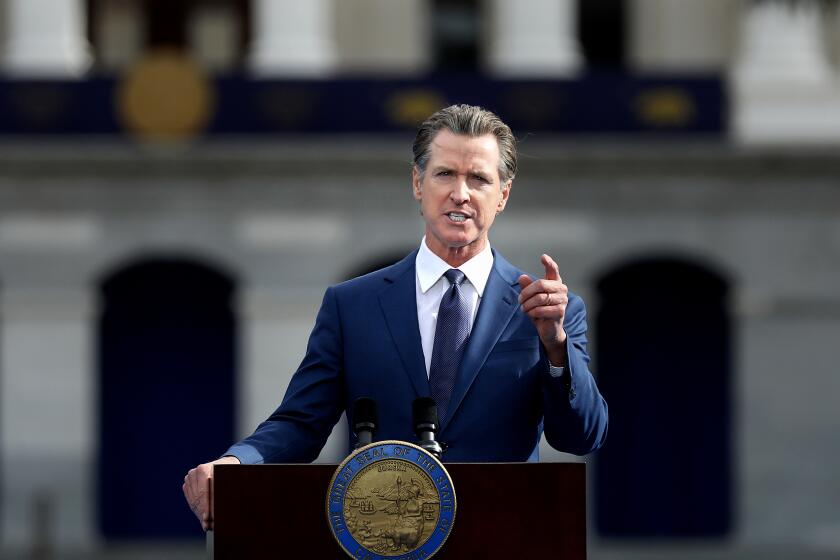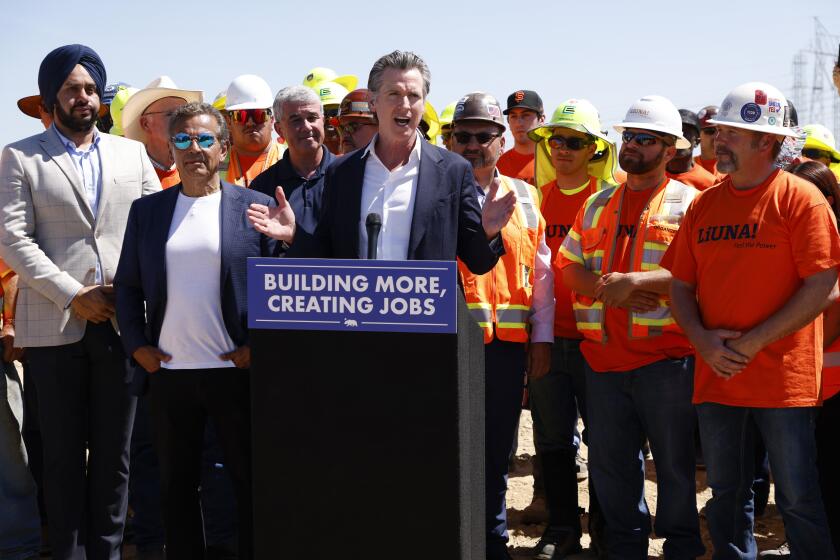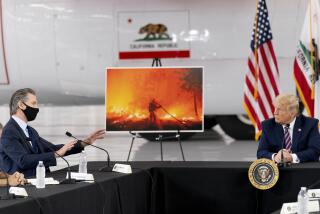Newsom’s signature move at the California Capitol: Jam the Legislature
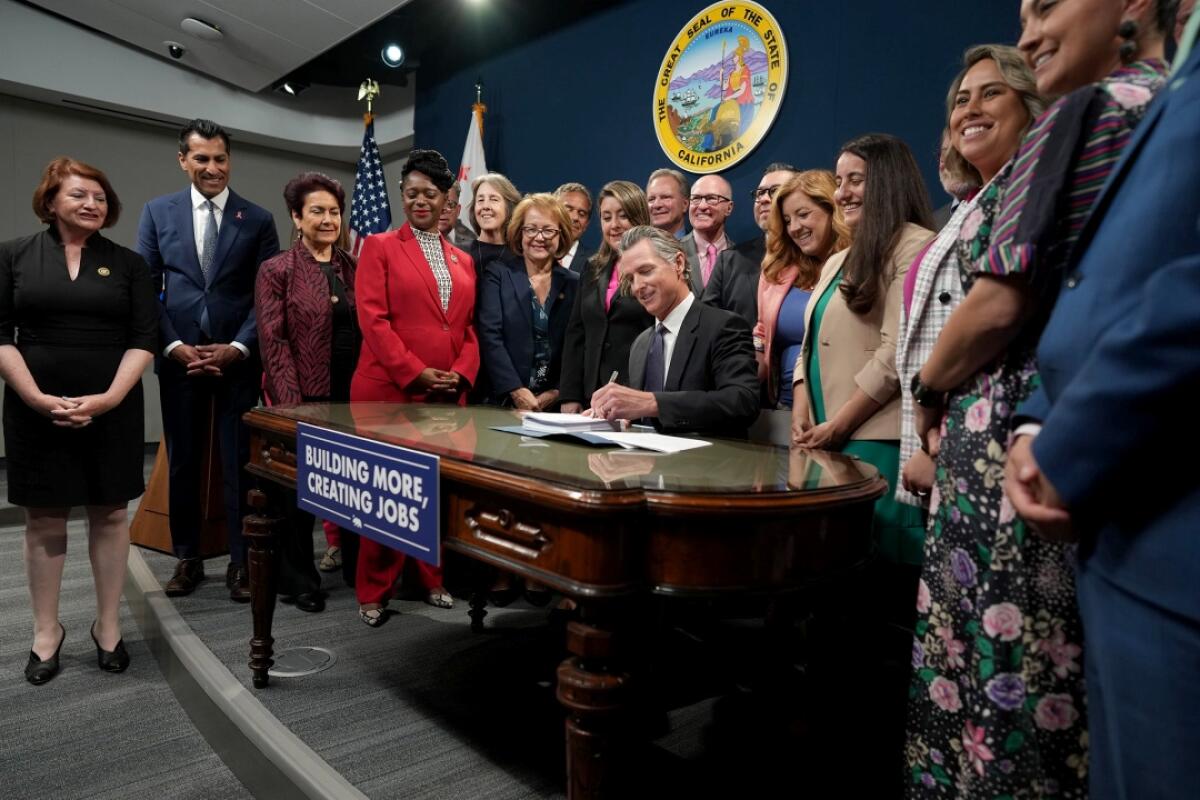
- Share via
In a talk at a climate summit in New York, Gov. Gavin Newsom in September said he “had to jam” his own Democratic Legislature in order to pass a series of climate bills in the final days before lawmakers adjourned last year.
The comment frustrated his legislative allies back in California and prompted Newsom to embark on an apology tour to smooth things over.
He’s tried to ram major policy through the statehouse twice more since then.
Every governor employs different strategies when stepping outside of traditional powers in the executive branch and into the public policy making arena in Sacramento, where the state Legislature is responsible for introducing, debating and passing legislation.
Some governors limit their policy agenda, creating little need to bargain with lawmakers. Many tether their marquee proposals to the state budget process that begins and ends with the governor. Others use their celebrity, or the statewide ballot, to force lawmakers to cut deals.
Whether born from a lack of patience or hard-nosed intentionality, the policy trademark of California’s 40th governor has become increasingly apparent in his second term. Newsom has a penchant for publicly manufacturing a sense of urgency and giving lawmakers as little time as possible to act.
“The process is always tough and I recognize I don’t necessarily always make it easy,” Newsom said at a news conference this month in Sacramento as he celebrated signing a series of infrastructure bills that he sprang on the Legislature in the 11th hour of the budget process.
“You weren’t supposed to snicker,” Newsom said to lawmakers standing next to him on stage.
Though said in jest, the governor was alluding to an uncomfortable reality. Despite the officials’ coming together for a photo opportunity that day, the tactic isn’t endearing Newsom to interest groups or his Democratic colleagues at the statehouse.
“Gavin Newsom has correctly decided that he’s willing to aggravate his allies because they need him more than he needs them,” said Thad Kousser, a professor of political science at UC San Diego who wrote a book about how governors succeed in passing bills and budget proposals. “He’s leveraging the publicity that every utterance that he makes creates in order to kind of create a political ultimatum when he wants the Legislature to do something.”
Gov. Newsom urged lawmakers to harden the state’s climate and energy goals, releasing a five-point legislative plan that promises to intensify his clash with the state’s powerful, billion-dollar oil industry.
So far, it’s produced mixed results.
Though Newsom’s tactic has helped him score some victories, it doesn’t always deliver everything he set out to win. The Democratic governor announced a special session for lawmakers to pass a penalty on excessive oil industry profits last fall just weeks after his mea culpa for suggesting lawmakers in Sacramento were beholden to the oil industry.
Feeling the political pressure of soaring gasoline prices, Newsom railed against Big Oil for “price-gouging” and taking advantage of Californians. Standing before television cameras in Sacramento, he said lawmakers had to pass a tax on oil industry profits in order to protect consumers now and “get every dollar, every cent back in the pockets of those who were fleeced.”
But the governor’s plan ran into problems from the jump.
No other state had successfully implemented a cap and penalty on oil profits. Without a blueprint to follow, lawmakers were worried a penalty could prompt the industry to continue to raise prices in California. Newsom acknowledged that navigating uncharted territory was a challenge.
The Legislature held its first public hearing on the proposal nearly five months after Newsom introduced the idea. By then, the governor’s office had presented only an outline of a plan to lawmakers with a yet-to-be-determined cap on profits as the administration struggled to figure out how to implement his idea.
Gas prices had also begun to drop, eliminating the governor’s urgency for lawmakers to act.
Newsom scrapped his original plan in March and instead settled on demanding more transparency from the oil industry in hopes of being better able to determine the cause of price spikes. Instead of lawmakers approving a cap on oil profits, the final law gave the California Energy Commission more authority to investigate gasoline prices and the option, through a public hearing process, to penalize oil companies.
“It’s the only thing you can do,” said Susan Kennedy, a former chief of staff to Gov. Arnold Schwarzenegger. “Every administration I’ve seen has dealt with gas prices through the roof and they do a study and they go after the oil companies and they do investigations on gas prices. I think I must have overseen five of them. That’s what you do because you have no control over supply and demand of oil.”
Despite falling short of his very public call for lawmakers to set a profits cap and penalty, Newsom cast his transparency bill as a major win against the oil industry.
Though Newsom presented his original penalty as imperative to protecting consumers, he acknowledged at the bill signing that “nothing is going to happen in the short term” and “prices are not going to drop immediately.” Nor is there any requirement for oil companies to pay consumers back for price spikes over the summer.
Gov. Gavin Newsom’s amended proposal would give the California Energy Commission more authority to investigate gasoline price spikes and cap profits.
Kousser said the governor’s declaration of victory in that instance reminded him of Schwarzenegger, who served two terms as California governor from 2003 to 2011.
“His problem, especially in his first year and a half, is he would come in with this thing... and the Legislature would just completely roll him and then he’d say, ‘Fantastic,’ ” Kousser said of Schwarzenegger. “He’d get something done and declare victory. Then he got this reputation for being like, OK, he just wants to get something so we can do whatever we want, and help take credit and be happy and that’ll all be fine.”
He said that’s also a danger for Newsom.
“It creates a sense that the governor is really not interested in the policy change,” Kousser said. “The governor might be interested in the political win. Once you get that reputation, that can hurt you.”
Newsom once again tried to jam lawmakers in May when he introduced a package of bills to speed up the process of building major infrastructure in California by limiting the opportunity for lengthy legal challenges to projects under the state’s marquee Environmental Quality Act.
Lawmakers and environmentalists criticized the late arrival of the package, the lack of time for sufficient public review of such a sweeping policy and the inclusion of Newsom’s existing plan to construct a tunnel to transport water under the Sacramento-San Joaquin River Delta to Southern California.
Kathryn Phillips, the former director of the Sierra Club California who publicly lambasted Newsom’s plan during the negotiations, said the infrastructure fight speaks to the “disdain he has for the environmental community.”
The governor often points out that his father was an environmentalist as an example of his deep roots within the movement. But Newsom “wants to be hailed as a leader of something he’s not exactly led,” she said.
“You gotta have people following you if you’re a leader,” Phillips said. “And when you just spring stuff on people, and you don’t talk to them, you’re not really leading. You’re imposing.”
Phillips also said Newsom’s desire to ram policies through is an example of his impatience with the legislative process, and in turn, disregard for public transparency and the vetting of public policy.
The strategy does provide a major advantage for Newsom, however: It limits time for opposition to mount and for lawmakers to water down the proposal through public hearings or stall as a negotiating tactic to leverage their own priorities. Legislative leaders have similarly introduced and passed controversial bills in the final days of the session.
“The governor is not interested in jamming the Legislature,” said Angie Wei, Newsom’s former legislative affairs secretary. “He’s interested in solving the big problems facing California. When your policy is done, it’s time to go. You can’t let the calendar hold you back.”
The governor has repeatedly commented on the limited time he has left at the helm of California government and his concern about having regrets for not doing more when his term ends in 2026.
“I want to actually deliver, not just on goals and ambitions, but on projects,” Newsom said when asked this month about shoehorning legislation. “And so I’m in a different mind-set. There’s a sort of hard-headed pragmatism. You know, let’s get moving.”
Democratic lawmakers have agreed on a preliminary state budget, but remain at odds with Gov. Gavin Newsom over his plan to speed up infrastructure construction.
Negotiations over the infrastructure package held up a budget deal between Newsom and lawmakers for weeks in Sacramento.
The governor threatened to veto the Legislature’s state budget unless lawmakers approved his infrastructure plan, an action that could have turned the Democratic infighting into a rare public spectacle.
Legislative leaders held out and ended up winning protections for disadvantaged communities. Newsom won many of the provisions he originally wanted to speed up projects, but dropped the delta tunnel from the proposal.
Former Assembly Speaker Anthony Rendon, who stepped down from his post leading the lower house this summer after the budget deal, said lawmakers are to blame for the way in which Newsom forces policies upon them. Legislators created a power imbalance when they left the state Capitol during the early days of the COVID-19 pandemic, he said, and allowed Newsom to run state government and enact policy alone.
“That carried over,” said Rendon (D-Lakewood), who was worried at the time about relinquishing power to the governor. “The Legislature weakened itself by not showing up and that relationship between the branches has never been the same. We love to piss on the administration and Gavin, but that’s something that was our fault. It was never rectified.”
More to Read
Sign up for Essential California
The most important California stories and recommendations in your inbox every morning.
You may occasionally receive promotional content from the Los Angeles Times.
